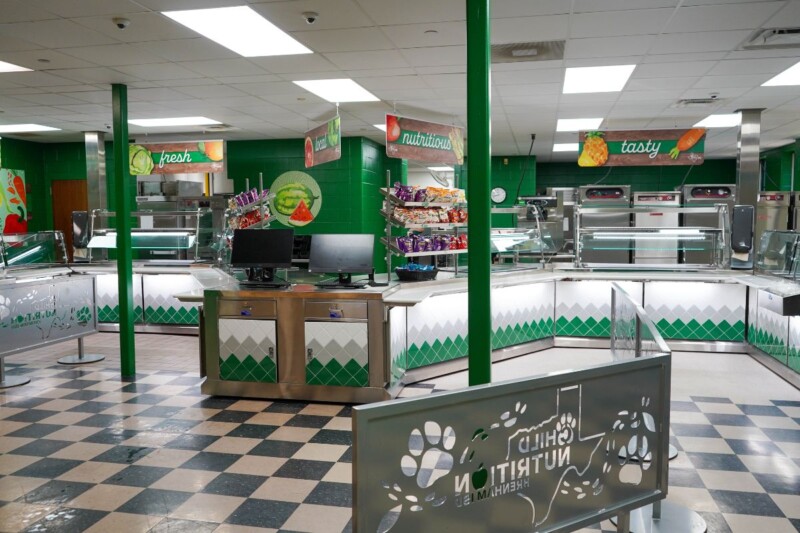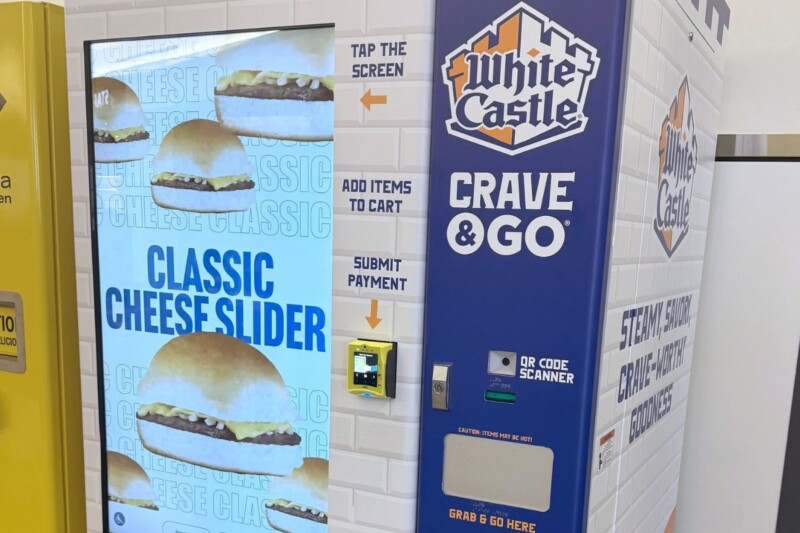When the new Pita Pit USA restaurant opened in August in Highland Heights, Ky. (not far from the Northern Kentucky University campus), the prototype featured upgrades any visitor might notice: a contemporary interior design package, eye-catching murals and updated menu graphics. But hidden in plain sight was an improvement only operators would appreciate: a “reversible” prep station.
Pita Pit USA’s “reversible” prep station—which allows operators to interchange the soup/smoothie station with a secondary sandwich station—is a reaction to the changing menu demands that vary according to market, weather and customer flow.
“Our goals were to improve speed of service, find a better POS provider, and better leverage our delivery and catering business,” says Duane Dlouhy, Pita Pit USA Director of Construction and leader of the team tasked with developing a prototype for the 249-unit, Coeur d’Alene, Idaho-based chain. It was founded in 1995 in Ontario, Canada.
Pita Pit USA leaders tasked themselves with tweaking an already efficient layout to create a better prototype and a more streamlined look. Typical Pita Pit restaurants cover only about 1,400 sq. ft. with seating for 26. The chain’s equipment line-up is equally space-efficient, featuring two sandwich prep tables, blenders for smoothies, a soup station and a griddle plus hood, plus back-of-house cold and dry storage and warewashing.
The Pita Proto
For more than 10 years, Pita Pit USA’s make-line has remained essentially the same: two sandwich tables facing front, the griddle and smoothie/soup station along the back wall.
“We had heard from our field operations team, however, that they sometimes felt the second sandwich station is not being used nearly as much as the soup and smoothie station on the back wall,” Dlouhy notes.
In short order, so to speak, Pita Pit began testing a layout with the soup/smoothie station along the front counter at its debut prototype restaurant, opened in Cerritos, Calif., in June.
The second sandwich table, now along the back wall, is dedicated to filling online, catering and delivery orders. “Our intention for the second sandwich station’s new back-wall position is to better support our online ordering/in-store pick-up initiative,” Dlouhy says. (Fans can now pre-order Pita Pit favorites using an app on their smartphones.)
In addition to bringing the soup/smoothie station to the front, the chain’s updated make-line features an L-shaped counter that has been softened with a 45° angle, now home to the main sandwich table.
“The goal is to keep workers as customer-facing as possible,” Dlouhy says. “Most workers build sandwiches at the angled station, which we placed farthest from POS because otherwise the queue backs up too quickly.” However, booming opening business at the Cerritos store revealed a challenge with the new “smoothie front” arrangement.
“We felt great about the layout in terms of speed-of-service and increasing our catering, delivery and smoothie business,” Dlouhy says. “However, several of our grand openings were so well-received that our crews could not [make sandwiches] fast enough using the one front-facing table. Our pita sandwiches are custom-made for each customer, who selects toppings and sauces as employees build the sandwich. That interaction cannot take place with the back-facing sandwich table.”
“Also, we realized our stores will need to be ready to handle the higher demand that comes with special events (festivals, street markets and so on),” Dlouhy continues. “We needed an option to capture all the business more efficiently.”
Reversible Revolution
The idea for Pita Pit’s flexible layout came about during a weekly store-opening meeting involving many staff members. “We discuss items that need to be accomplished in construction, training, marketing before each store opening, and we also cover the pluses and minuses of recent openings—which is how we landed upon the reversible line concept,” Dlouhy says.
Designers went back to the drawing board to create a make-line in which the secondary sandwich table could be interchanged with the smoothie and soup station to best meet an individual store’s needs. Developing the reversible line proved relatively easy. “We matched the width of the sandwich table—72 in.—to that of the smoothie/soup table,” Dlouhy says. Casters and simple plug-in utility hook-ups make the tables easy to swap.
“Voltage requirements for the smoothie and soup station are the same as for the True sandwich prep table,” Dlouhy points out. “The only difference is, the smoothie station requires a few more wall outlets, so we make sure this is indicated when roughing in the electrical needs.”
Jim Swan is Owner of the Highland Heights, Ky., Pita Pit, the first in the country to open a store with the reversible line. “Exchanging the two tables requires two team members and about 10 minutes,” says Swan, whose store opened in August with both sandwich tables along the front line. Then, he swapped the two stations’ positions to gauge the impact on sales.
Not surprisingly, putting the smoothie station front and center boosted smoothie sales. “I could tell the [smoothie-front format] drew customer attention as they walked up—the two blenders frame up the smoothie menu very well,” Swan reports. “And over the week of testing the swapped arrangement, we did see an increase in the number of smoothies sold. Employees liked having the station up front because it allowed the person working the POS terminal to still interact with the customers as they were making a smoothie.” The switch also helped workers save steps, since they weren’t moving back and forth between customers and blenders. With regards to scheduling a future “swap,” Swan says, “I’m pleased with the results and will only switch back when I see the need to operate both sandwich lines at once or we roll out strong with delivery. As for what I learned from the experiment, it drove home that most customers purchase things like smoothies based on impulse. It changed the smoothie from an extra to an impulse buy. Also, we’ve found that with [smoothies] being up front, when one is ordered during a rush, more will get ordered because people see them being made. Over the course of a year, the [increased smoothie sales] could lead to a good jump in revenue.”
Designed For Delight
Pita Pit’s overall look received a makeover in the new prototype as well. “Our goals were to give customers a fresher experience, so they could focus on the flavor combinations rather than possibly being confused by the many choices on our previous menu boards,” says Pita Pit Marketing Director Patrick O’Dell.
Both the Cerritos and the Highland Heights restaurants showcase Pita Pit’s streamlined set-up. “We simplified the menu board, took away the little cartoon character illustration and as a result created an easier ordering experience,” O’Dell says.
In addition to the menu board, the Pita Pit proto now includes an eye-catching mural where possible that will engage guests from both inside the store and out. “The linear wall is a 40-ft.-long by 4-ft.-tall mural running the length of the store,” says O’Dell, noting that the Cerritos location doesn’t feature the graphic because of its many windows. “It’s lit from the top, and is visible even after hours to anyone passing the store. The mural blends key phrases with great food photography that together will encourage our guests to try new flavor combinations. It’s going to really make our stores ‘pop.’”
A Look Ahead
Building new units and retrofitting existing Pita Pit locations is part of the chain’s focus for the months ahead. About 40 new Pita Pit locations are expected to open in ’17, and about 15 existing restaurants plan to update to the new look and reversible line next year.
“It’s not a hard process,” Dlouhy says. “Updating the line to make it reversible involves replacing the old counters with new. The new counters with the reclaimed wood look are very popular with franchisees. We expect a lot of participation.”
Pita Pit recommends new stores open with both sandwich stations at the front to handle potential volume. “If traffic doesn’t warrant two front-facing sandwich stations, then operators can swap to better merchandise their smoothies and soups,” Dlouhy says. “In stores that are strong in catering and delivery, however, we recommend the sandwich station be against the back wall from the beginning.”
EQUIPMENT
True sandwich prep tables, refrig. base, refrig., freezer, refrig. merchandiser
CaptiveAire hood
Star/Middleby 36-in. griddle
Custom microwave
Tarrison 3-comp. pot sink, hand sinks
Dormont pre-rinse accessories
Nor-Lake/Standex walk-in cooler, freezer
Blendtec blenders
Manitowoc ice machine
Berkel/ITW FEG slicer
Server Products soup kettle
Johnny Counters millwork
Otis Spunkmeyer cookie oven
Roundup/Antunes bread warmer
Edlund/Ali Group can opener
SPECS
MENU/SEGMENT: Quick-casual pita sandwiches
HEADQUARTERS: Coeur d’Alene, Idaho
FOUNDED: 1995 in Kingston, Ontario, Canada
NUMBER OF UNITS: 249
SIZE: 1,400 sq. ft.
SEATS: 26
FF&E PACKAGE: about $100,000
2016 OPENINGS: 36
2017 PLANS: 40 openings
DESIGNERS: Duane Dlouhy, Director of Construction, Pita Pit USA, Coeur d’Alene, Idaho; Nelson Costa, Construction V.P., Pita Pit Canada, Kingston, Ontario
DEALER: Hendrix Restaurant Equipment & Supplies, Brockville, Ontario
WEB: pitapitusa.com
“””
RELATED CONTENT
- Advertisement -
- Advertisement -
- Advertisement -
TRENDING NOW
- Advertisement -
- Advertisement -
- Advertisement -


